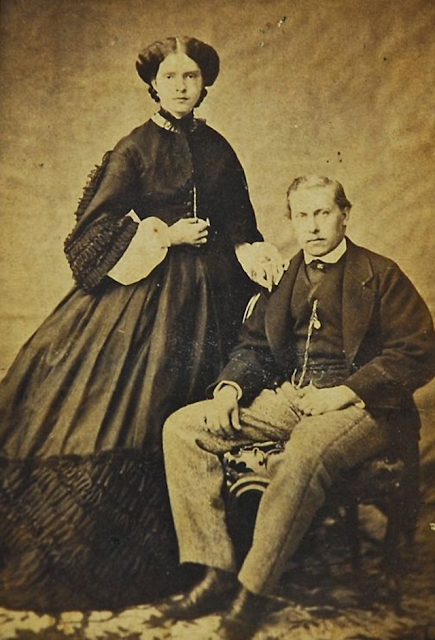Queen Maria Pia of Portugal was an Italian princess who married King Luis of Portugal. Read more about her story in this article.
 |
| A portrait of Queen Maria Pia of Portugal. |
Dona Maria Pia was born on 16 October 1847, at the Royal Palace in Turin, in the kingdom of Sardinia. She was the fifth and youngest child of King Victoria Emmanuel II, who became the the first king of Italy, and Archduchess Adelaide of Austria, a daughter of Archduke Rainer and Princess Elisabeth of Savoy. She was only 14 years old when she married King Luis of Portugal (1838-1889), first by proxy in Italy, and then in the São Domingos Church in Lisbon on October 6, 1862. She gave birth to two sons, Dom Carlos (1863-1908), later King of Portugal, and Dom Afonso (1865-1920).
Maria Pia was a tall woman, elegant of bearing, a queen in dignity but, like her sister, Clotilde, possessed of a certain reserve of character, and yet blended, to those who knew her, with some of the bonhomie of her famous father, the Re Galantuomo, King Victor Emmanuel II. Like him, also, in earlier and happier years, she was a keen sportswoman, an intrepid rider, and extremely fond of hunting and shooting. |
| The wedding procession of King Luis and Queen Maria Pia's wedding in 1862. Image from Wikimedia Commons. |
 |
| Commemorative fan celebrating the wedding of King Luis and Queen Maria Pia in 1862. From Wikimedia Commons |
Her husband, King Luis, was devoted to art and literature. He translated into Portuguese the Merchant of Venice, Othello, and Hamlet. Queen Maria Pia shared these interests, and was herself skilled in music and painting. While his cultural genius was impeccable, he nevertheless lagged behind political affairs and was deemed to be an ineffective ruler.
Queen Maria Pia played a very active part in Portuguese political affairs during the reigns of his husband and son. In fact, her headstrong character was influential in suppressing attempts against the king, which might have caused the indolent easygoing King his throne. On one memorable occasion, when the disreputable old Field-Marshal, Duke of Saldanha, had by means of a military pronunciamiento forced some unpalatable measure upon the King, she, addressing him in the hearing of the entire Court and Ministers, expressed the strongest kind of regret that she was merely Queen, instead of the King, since it prevented her from having him either, shot or hanged for his treason to the crown. Anxious on the accession to the throne of his elder son, now King Carlos, she insisted that he refer to her as his mother, not just in domestic and family affairs, but also in political matters. In fact, it was she herself who insisted upon surrendering to him, as chief of the family, all the authority that she had until then enjoyed, and, in abandoning to his consort, her daughter in-law, the status and precedence of the first lady of the land.
 |
| Queen Maria Pia in a sumptuous gown and ermine trimmed headdress (1864). Image from Wikimedia Commons |
 |
| King Luis and Queen Maria Pia, c1864. Image from Wikimedia Commons. |
But far more than by these accomplishments, the Queen was endeared to the people of Lisbon by her philanthropy. While considered by some as extravagant, she spent far more for her many charitable works in aid of the Portuguese people. For 40 years she was known as the ''Angel of Charity.”
Queen Pia endured a series of loss within her family. In 1900, an anarchist murdered her brother, King Umberto of Italy, to whom she was deeply devoted. Eight years later, that almost forgotten tragedy was followed by the loss in a similar manner of her son and grandson. She was particularly close to Dom Carlos and so deeply was he attached to her that when in Lisbon he never allowed a single day to pass without out meeting her. A superb swimmer, she was the only woman of sovereign rank who had been decorated for plunging into the sea to rescue a fellow creature from drowning.
 |
| King Luis and Queen Maria Pia. Image from Wikimedia Commons |
The assassination of her son King Carlos I of Portugal and grandson Crown Prince Luís Filipe,
Duke of Braganza, on February 1, 1908 on the Praça do Comércio in Lisbon
gravely devastated her. She finally he withdrew from the public eye and she was
hurt further after the military coup that deposed her remaining grandson, King
Manuel II of Portugal, during the October 5,
1910 Revolution. Queen Maria Pia and her son, Infante Afonso, went to
her native Italy, where she died heartbroken on the July 5, 1911 in Stupinigi. She
was interred in the Basilica of Superga.

.png)




1 Comments
Even if average life expectancy was shorter in the 19th century, it still must have been horrific for Queen Maria Pia to live through her beloved family's murders, accidents and diseases. Being royal didn't necessarily make life easier or happier :(
ReplyDelete